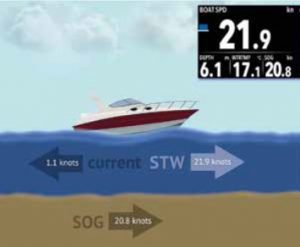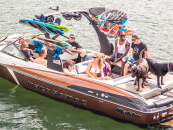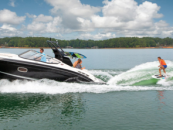The difference between Speed over Ground (SOG) and Speed Through the Water (STW) is a common occurrence in boating.
Here are some key points to understand why SOG and STW may differ:
1 SOG and STW: Satellite navigation systems calculate SOG, which is the actual speed of the boat relative to the Earth’s surface. It is sometimes referred to as “speed over the chart.” STW, on the other hand, is the speed measured by the boat’s speed instrument or log, indicating the speed through the water.
2 Tidal or river currents: If the water in which your boat is floating is influenced by tidal or river currents, the current can affect the boat’s speed relative to the ground. This can result in a difference between SOG and STW. For example, if there is a 1.1-knot tidal current against the boat’s 21.9-knot STW, the resulting SOG would be 20.8 knots.
When measuring speed through the water, a speed instrument (often still called a log) uses a transducer mounted either through the hull or on the transom that should spin freely without any drag.
3 Other factors affecting speed: Variations between SOG and STW can also occur due to other factors that impact the boat, such as waves, wind, and additional current effects. These factors can affect the boat’s progress through the water, leading to differences between SOG and STW.
4 Importance of measuring STW: Measuring STW allows you to assess your progress through the water accurately. It helps ensure you don’t miss critical arrival times, such as reaching a tidal window, bridge opening, or lock operation. Understanding the impact of tidal currents also contributes to reducing your environmental footprint.
5 Calibrating the speed instrument: Speed instruments or logs use transducers, typically paddlewheel-type, to measure STW. It is essential to keep the transducer clean and free from fouling, as any obstruction can affect its accuracy. You can calibrate your speed instrument by comparing its readings with GPS-derived SOG in calm conditions with no current.
6 Errors in speed readings: Even with a clean transducer, there may be variations in the STW readings compared to the actual speed through the water. Factors such as hull design, hull condition, propeller effect, and water flow disturbance can contribute to inaccuracies. You can add a correction factor in your marine electronics to account for these errors.
7 Changes over time: Changes in STW can occur due to factors like extra load on the boat, hull fouling, engine issues, or propeller damage. These factors will also affect SOG. If you notice increasing variation between STW and SOG, it’s important to check the transducer and ensure the satellite antenna has a clear view of the sky for consistent position information.
Understanding the differences between SOG and STW and monitoring them can provide valuable information for safe and efficient boating. Regular checks, maintenance, and calibration of your speed instrument will help ensure accurate speed measurements.
For electronics installations: Harald Farthofer Ph: 0403 950 709 harald@aseamarine.com.au
Published in print October-December 2023






























